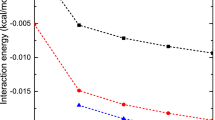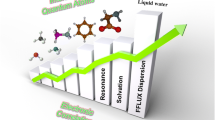Abstract
Slater-type geminals (STGs) have been used as explicitly correlated two-electron basis functions for calculations on the hydrides of N–As and Sb (as well as on the hydrides of O–Se and F–Br with similar, not reported results) in various one-electron basis sets of Gaussian atomic orbitals. The performance of the explicitly correlated theory has been assessed with respect to the exponent of the STG, for example, by using different exponents for individual pair correlation functions and pair energies. It is shown that a correlation factor with an exponent of \({\gamma = 1.4 a_{0}^{-1}}\) can give reliable results within 1% from the basis-set limit for all investigated molecules in an aug-cc-pVQZ basis set for the valence shells, using fixed amplitudes for the STGs in a diagonal orbital-invariant formulation of the theory. The use of relativistic effective core potentials (RECPs) in explicitly correlated second-order perturbation theory has been investigated.
Similar content being viewed by others
References
Hylleraas EA (1929) Z Phys 54: 347
Rychlewski, J (eds) (2003) Explicitly correlated wave functions in chemistry and physics. Progress in Theoretical Chemistry and Physics, vol. 13. Kluwer, Dordrecht
Scott TC, Lüchow A, Bressanini D, Morgan JD III (2007) Phys Rev A 75: 060101
Persson BJ, Taylor PR (1996) J Chem Phys 105: 5915
Polly R, Werner H-J, Dahle P, Taylor PR (2006) J Chem Phys 124: 234107
Dahle P, Helgaker T, Jonsson D, Taylor PR (2007) Phys Chem Chem Phys 9: 3112
Cencek W, Rychlewski J (1993) J Chem Phys 98: 1252
Cencek W, Rychlewski J (1995) J Chem Phys 102: 2533
Kutzelnigg W (1985) Theor Chim Acta 68: 445
Klopper W, Manby FR, Ten-No S, Valeev EF (2006) Int Rev Phys Chem 25: 427
Werner H-J, Adler TB, Manby FR (2007) J Chem Phys 126: 164102
Klopper W, Samson CCM (2002) J Chem Phys 116: 6397
Valeev EF (2004) Chem Phys Lett 395: 190
Ten-no S (2004) Chem Phys Lett 398: 56
Manby FR, Werner H-J, Adler TB, May AJ (2006) J Chem Phys 124: 094103
Kedžuch S, Milko M, Noga J (2005) Int J Quantum Chem 105: 929
Turbomole, Version 5.10 (January 2008), Turbomole GmbH. http://www.turbomole.com (the MP2-F12 program has not yet been released)
Tew DP, Klopper W, Manby FR (2007) J Chem Phys 127: 174105
Klopper W (1991) Chem Phys Lett 186: 583
Klopper W, Kutzelnigg W (1987) Chem Phys Lett 134: 17
Kato T (1957) Commun Pure Appl Math 10: 151
Ten-no S (2004) J Chem Phys 121: 117
Ahlrichs R (2006) Phys Chem Chem Phys 8: 3072
Obara S, Saika A (1985) J Chem Phys 84: 3963
Höfener S, Bischoff FA, Glöß A, Klopper W (2008) Phys Chem Chem Phys (accepted for publication)
Ten-no S (2007) J Chem Phys 126: 014108
Manby FR (2003) J Chem Phys 119: 4607
Glöß A (2007) Ph.D. thesis, Universität Karlsruhe (TH), Karlsruhe
Ahlrichs R, Bär M, Häser M, Horn H, Kölmel C (1989) Chem Phys Lett 162: 165
Hättig C, Weigend F (2000) J Chem Phys 113: 5154
Weigend F, Ahlrichs R (2005) Phys Chem Chem Phys 7: 3297
Tew DP, Klopper W (2006) J Chem Phys 125: 094302
Dunning TH (1989) J Chem Phys 90: 1007
Woon DE, Dunning TH (1993) J Chem Phys 98: 1358
Dunning TH, Peterson KA, Wilson AK (2001) J Chem Phys 114: 9244
Wilson AK, Woon DE, Peterson KA, Dunning TH (1999) J Chem Phys 110: 7667
Peterson KA (2003) J Chem Phys 119: 11099
Metz B, Stoll H, Dolg M (2000) J Chem Phys 113: 2563
Hellweg A, Hättig C, Höfener S, Klopper W (2007) Theor Chem Acc 117: 587
Weigend F, Köhn A, Hättig C (2002) J Chem Phys 116: 3175
Tew DP, Klopper W (2005) J Chem Phys 123: 074101
Valeev EF (2006) J Chem Phys 125: 244106
Author information
Authors and Affiliations
Corresponding author
Rights and permissions
About this article
Cite this article
Bischoff, F.A., Höfener, S., Glöß, A. et al. Explicitly correlated second-order perturbation theory calculations on molecules containing heavy main-group elements. Theor Chem Account 121, 11–19 (2008). https://doi.org/10.1007/s00214-008-0441-8
Received:
Accepted:
Published:
Issue Date:
DOI: https://doi.org/10.1007/s00214-008-0441-8




